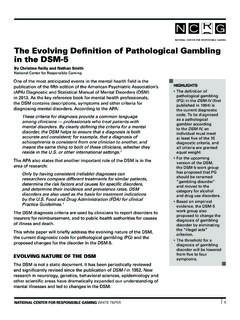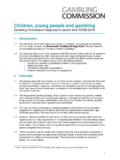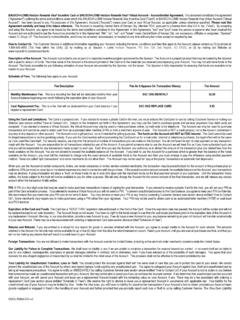Transcription of Women and Artisanal Mining: Gender Roles and the …
1 Chapter 11 book: The Socio-Economic Impacts of Artisanal and Small-Scale Mining in Developing Countries Ed. G. Hilson, Pub. Balkema, Swets Publishers, Netherlands, 2003 Women and Artisanal Mining: Gender Roles and the Road Ahead Jennifer J. Hinton1, Marcello M. Veiga2, Christian Beinhoff2 1. Dept. of Mining Engineering, University of British Columbia, Vancouver, BC Canada 2. United Nations Industrial Development Organization (UNIDO), Vienna, Austria. A hot, dry wind envelopes a statuesque woman as she kneels over wind-sifted trays of tin-bearing pulverized ore in Uis, Namibia. In Bolivia, a nine-year old girl scrambles down a steep pit wall yet again to refill her bucket of metal-rich sand. And yet another woman stokes the fire in her wood burning stove in the Philippines, releasing the mercury from dor in a poorly ventilated kitchen; the thick black soot coating the kitchen wall contains more than 15% mercury.
2 Up to her knees in muddy water, a woman pans for gold to supplement the meagre family income in a Malian orpaillage . The faces are as varied as these scenarios but there is one commonality Artisanal mining represents an opportunity. To some, participation is driven by the allure of riches; however, for many Women , Artisanal mining signifies an opportunity to relieve the strains of poverty1. Artisanal miners2 employ rudimentary techniques for mineral extraction and often operate under hazardous, labour-intensive, highly disorganized and illegal conditions. Despite these factors, Artisanal mining is an essential activity in many developing countries, particularly in regions where economic alternatives are critically limited.
3 The International Labour Organization (1999) estimates that the number of Artisanal miners is currently around 13 million in 55 countries, which is roughly equivalent to the global workforce of large-scale mining. From this, it has been extrapolated that 80 to 100 million people worldwide are directly and indirectly dependent on this activity for their livelihood. ILO further estimates that Artisanal mining 1 The term poverty is used in a broad sense in this chapter. As described by agatay (2001), poverty refers to human poverty , which includes lack of assets, dignity, autonomy and time in addition to income poverty. 2 Artisanal mining is used to denote all small-scale as well as medium and large-scale mining that may be illegal or legal, formal or informal.
4 Artisanal mining may be better characterized by a lack of long-term mine planning and use of rudimentary techniques (Hinton et al., 2003). activities have increased by up to 20% in the past decade. Approximately 30% of the world s Artisanal miners are Women who occupy a number of Roles ranging from labour-intensive mining methods to the processing aspect of Artisanal mining, including amalgamation with mercury in the case of gold extraction. As processing activities are often conducted in the home, Women and their families can be at great risk from mercury poisoning and silicosis. In many cases, the Roles of Women in Artisanal mining communities differ significantly from those of men, and extend well beyond direct participation in mining activities this added facet brings with it different contributions and a completely unique set of risks and opportunities.
5 This chapter intends to explore existing and evolving gender3 Roles of Women in Artisanal mining communities, and provides a rationale and strategy for Women to maximize potential benefits from participation in the sector. Women are often overlooked by initiatives and development programmes directed at catalyzing the transformation of Artisanal mining. Due to their critical role, not only in mineral production, but also in the development of sustainable communities, combined with their susceptibility to poverty, enhancing the role of Women in Artisanal mining may be a means to bridge the gap between the well- conceived technical and socio-economic changes often prescribed for Artisanal mining, and the actual facilitation of positive transformation of the Artisanal mining sector.
6 This may be accomplished in a number of ways, including: Gender -sensitive technology assistance initiatives; 3 Gender , as applied herein, refers to the behaviours, attitudes, values, beliefs, etc. that a particular socio- cultural group considers appropriate for males and females. The authors adhere to the belief that Gender Roles are fluid and can shift over time, space and in different contexts (Butler, 1990). Chapter 11 - The Socio-Economic Impacts of Artisanal and Small-Scale Mining in Developing Countries 2 Enhancement of other skills, including managerial and accounting; Financial support through the establishment of credit lines and micro-lending programmes; Support for the acquisition of mineral titles; Consideration of Women in the development of regulations and policies; The awareness of health and safety issues, with consideration of children who may accompany their mothers or take part in Artisanal mining activities; and The challenging of social norms which prevent Women from benefiting from these activities.
7 It has been well documented that inequities in political power, distribution of income, capital assets, and access to education and information have resulted in the increased susceptibility of Women to chronic poverty. In some cultures, this is exacerbated by the fact that Women do not always have control of their earned income or they occupy positions in the unpaid economy ( subsistence agriculture, domestic work). Ultimately, it is crucial that Women be empowered to transform their skills and capabilities into well-being. Artisanal mining is only one micro-industry; however, as Labonne (1996) articulated ( Artisanal ) may become a stepping stone towards economic fulfillment, contributing to a better future for Women and men in many developing countries.
8 PARTICIPATION OF Women IN Artisanal MINING COMMUNITIES Artisanal mining communities around the world are diverse, dynamic and distinct they vary from culture-to-culture, region-to-region and mine-to-mine, and change over the course of time. The Women within these communities are also heterogeneous and unique; however, they tend to be engaged in specific Roles throughout the world. Typically, they are labourers ( panners, ore carriers and processors), providers of goods and services ( cooks, shopkeepers) and are often solely responsible for domestic chores. Women s responsibilities in mineral processing activities range from crushing, grinding, sieving, washing and panning, to amalgamation and amalgam decomposition in the case of gold mining.
9 Less commonly, Women are concession owners, mine operators, dealers and buying agents, and equipment owners. In many locales, Women function in multiple capacities. For instance, a Women working as a panner may also obtain income as a sex trade worker and a cook. Despite the diverse and important Roles undertaken by Women in Artisanal mining, limited reliable information is available on this topic. The numbers of Women involved have been estimated in several countries; however, there are very few accounts telling the stories of individual Women and a paucity of information concerning the age, ethnicity, status, wealth, and health of both Women and men in these communities. Since the participation of Women in non-mining activities is often overshadowed by their involvement in mining, their direct and indirect Roles in Artisanal mining communities are discussed independently below.
10 Women as Miners Women s direct participation in Artisanal mining varies throughout the world. In Asia, generally less than 10% of miners are Women , whereas in Latin America, the proportion tends to be higher, approximately 10-20%. The percentage of female Artisanal miners is the highest in Africa, ranging between 40 and 50%. In some regions, the Artisanal mining workforce is comprised of 60 to 100% Women (ILO, 1999; Amutabi and Lutta-Mukhebi, 2001; Onuh, 2002). Women typically play a much larger role in Artisanal mining than in the large scale mining sector (WMMF, 2000). Statistics on the participation of Women derived from country studies commissioned through the Mining, Minerals and Sustainable Development initiative are shown in Table 1.















